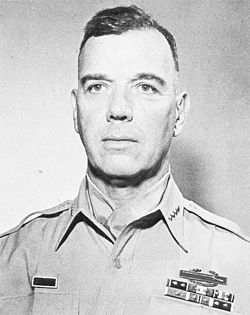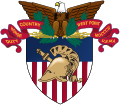| Rank | Name | Rank in class | Notes | |
|---|
11 
General of the Army | Bradley, Omar Omar N. Bradley | 44 | Commanded 82nd Infantry Division (1942), 28th Infantry Division (1942), II Corps (1943), First Army (1944), Twelfth Army Group (1944–1945); served as Chief of Staff of the United States Army (1948–1949), Chairman of the Joint Chiefs of Staff (1949–1953) | [1] [66] |
11 
General of the Army | Eisenhower, Dwight Dwight D. Eisenhower | 61 | Supreme Allied Commander, North African Theater of Operations (1942–1943), Supreme Allied Commander Europe (1942, 1943–1945, 1949–1952), Chief of Staff of the United States Army (1945–1948), President of the United States (1953–1961) | [1] [67] |
10 
General | McNarney, Joseph Joseph T. McNarney | 41 | Deputy Chief of Staff, U.S. Army (1942–1944), Supreme Allied Commander, Mediterranean Theater of Operations (1944–1945), commanded U.S. Forces in Europe (1945–1947), commanded Air Materiel Command (1947-1949) | [66] [68] |
10 
General | Van Fleet, James James Van Fleet | 92 | Commanded 4th Infantry Division, 90th Infantry Division, III Corps in World War II; U.S. Eighth Army in the Korean War (1951–1953) | [69] [70] |
09 
Lieutenant General | Aurand, Henry Henry Aurand | 20 | Commanded 6th Service Command (1942–1944), Deputy Chief Ordnance Officer, European Theater of Operations (1944), commanded Normandy Base Section (1944–1945), Services of Supply China Theater (1945), U.S. Army Pacific (1949) | [36] [71] [72] |
09 
Lieutenant General | Harmon, Hubert Hubert R. Harmon | 103 | Commanded Sixth Air Force (1942–1943, 1946–1947), Thirteenth Air Force (1943–1944), Superintendent of the United States Air Force Academy (1954–1956) | [73] [74] |
09 
Lieutenant General | Irwin, Stafford Stafford LeRoy Irwin | 40 | Commanded 5th Infantry Division, XII Corps, V Corps, U.S. Forces Austria (1950–1952) | [66] [75] |
09 
Lieutenant General | Larkin, Thomas Thomas B. Larkin | 21 | Chief of Staff, Services of Supply, U.S. Army Forces, British Isles (1942–1943); Commanded Services of Supply, North African Theater of Operations (1943), Communications Zone, North African Theater of Operations (1943–1944), Southern Line of Communications, Communications Zone, European Theater of Operations (1944–1945), 2nd Service Command (1945); Quartermaster General of the U.S. Army (1946–1949), Deputy Chief of Staff for Logistics (1949–1952) | [36] [76] |
09 
Lieutenant General | Leonard, John John W. Leonard | 84 | Commanded 9th Armored Division (1942–1945), U.S. Army Armor School (1946–1948), V Corps and XVIII Airborne Corps (1951–1953) | [77] [78] |
09 
Lieutenant General | Stratemeyer, George George E. Stratemeyer | 147 | Commanded Army Air Forces China-Burma-India Theater of Operations (1943–1946), Air Defense Command (1946–1948), Continental Air Command (1948–1949), Far East Air Forces (1949–1952) | [79] [80] |
09 
Lieutenant General | Swing, Joseph Joseph M. Swing | 38 | Commanded 11th Airborne Division (1943–1948), I Corps (1948–1949), Sixth Army (1951–1954) | [81] [82] |
08 
Major General | Bragdon, John Stewart John Stewart Bragdon | 5 | Assistant Chief of Military Construction (1945–1949); Deputy Chief of Engineers (1950–1951) | [83] [84] |
08 
Major General | Cousins, Ralph P. Ralph P. Cousins | 129 | Commanded Army Air Force Western Flying Training Command (1942–1946) | [85] [86] |
08 
Major General | Covell, William E. R. William E. R. Covell | 1 | Director of Fuels and Lubricants, Office of Quartermaster General (1943–1944); Commanded Services of Supply China-Burma-India Theater (1944–1945) | [84] [87] |
08 
Major General | Esteves, Luis R. Luis R. Esteves | 97 | Adjutant General of Puerto Rico (1939–1957) | [70] [21] |
08 
Major General | Evans, Vernon Vernon Evans | 55 | Deputy Chief of Staff and Chief of Staff China-Burma-India Theater (1944–1945) | [88] [89] |
08 
Major General | Hanley, Thomas J. Thomas J. Hanley Jr. | 124 | Commanded Air Service Command, Army Air Forces China-Burma-India Theater (1944–1945), Eleventh Air Force (1946–1948) | [86] [90] |
08 
Major General | Hearn, Thomas G. Thomas G. Hearn | 106 | Chief of Staff China-Burma-India Theater (1944); Commanded Infantry Replacement Training Center (1944–1945) | [74] [91] |
08 
Major General | Hobbs, Leland S. Leland S. Hobbs | 46 | Commanded 30th Infantry Division (1942–1945), 2nd Armored Division (1946–1947), IX Corps (1949–1950) | [92] [93] [94] |
08 
Major General | Lester, James A. James A. Lester | 23 | Commanded 24th Division Artillery, XIV Corps Artillery, 24th Infantry Division | [36] [37] |
08 
Major General | Lyon, Edwin B. Edwin B. Lyon | 48 | Commanded VI Bomber Command (1941–1943), Antilles Air Command (1943); Deputy Commander, Army Air Force Flying Training Command (1944–1945); Commanded Air Forces Mid Pacific (1945–1946) | [93] [95] |
08 
Major General | Miller, Henry J. F. Henry J. F. Miller | 110 | Commanded Air Material Command European Theater of Operations (1943–1944). Reduced in rank to lieutenant colonel in May 1944 as the result of a security breach. Retired for disability in November 1944. Promoted to brigadier general on the retired list in 1948. | [57] [96] [97] |
08 
Major General | Mueller, Paul J. Paul J. Mueller | 45 | Commanded 81st Infantry Division (1942–1946) | [93] [98] |
08 
Major General | Prichard, Vernon E. Vernon Prichard | 134 | Commanded 14th Armored Division (1942–1944), 1st Armored Division (1944–1945) | [99] [100] |
08 
Major General | Richards, George J. George J. Richards | 6 | War Department General Staff (1943–1947) | [84] [101] |
08 
Major General | Ryder, Charles W. Charles W. Ryder | 39 | Commanded 34th Infantry Division (1942–1944), IX Corps (1944–1948) | [82] [102] |
08 
Major General | Sayler, Henry B. Henry B. Sayler | 37 | Chief Ordnance Officer, European Theater of Operations (1942–1945) | [82] [103] [104] |
08 
Major General | Tompkins, William F. William F. Tompkins | 16 | War Department General Staff (1943–1945) | [105] [106] |
08 
Major General | Waldron, Albert W. Albert W. Waldron | 32 | Field Artillery Representative, Army Ground Forces (1943–1946) | [107] [108] |
08 
Major General | Walton, Leo A. Leo A. Walton | 128 | Air Inspector Army Air Force China Theater (1945–1946); Commanded Fourteenth Air Force (1946–1948) | [86] [109] |
08 
Major General | Watson, Leroy H. Leroy H. Watson | 151 | Commanded 3rd Armored Division (1943–1944), 79th Infantry Division (1945). Commands before 1953 retirement included: International Military Tribunal Command, Germany; Southern District, Sixth United States Army; Fort Lewis; Chief of Civil Affairs, U. S. Far East Command; and U.S. Defense Advisory Group, Japan. | [80] [110] |
08 
Major General | Weart, Douglas L. Douglas L. Weart | 10 | Chief of Staff, Caribbean Defense Command (1943–1944); Deputy commander China Theater (1945) | [106] [111] |
08 
Major General | White, A. Arnim A. Arnim White | 158 | Chief of Staff, U.S. Seventh Army (1944–1945); Commanded 75th Infantry Division and 71st Infantry Division (1945–1946) | [112] [113] |
08 
Major General | Wogan, John B. John B. Wogan | 75 | Commanded 13th Armored Division (1942–1945) | [114] [115] |
08 
Major General | Woodruff, Roscoe B. Roscoe B. Woodruff | 56 | Commanded 77th Infantry Division (1942–1943), VII Corps (1943–1944), 24th Infantry Division (1944–1945), I Corps (1945–1948), XV Corps (1951–1953) | [89] [116] |
07 
Brigadier General | Beukema, Herman Herman Beukema | 26 | Director of Army Specialized Training Program | |
07 
Brigadier General | Bank, Carl C. Carl C. Bank | 53 | Artillery Officer Allied Forces Headquarters, North African Theater of Operations (1942–44); Commanded 13th Field Artillery Brigade (1944–1945) | [89] [119] |
07 
Brigadier General | Boye, Frederic W. Frederic W. Boye | 150 | Served in China (1944–1945) | [80] [120] |
07 
Brigadier General | Busbee, Charles M. Charles M. Busbee | 31 | Commanded 102nd Division Artillery (1942–1946) | [108] [121] |
07 
Brigadier General | Conklin, John F. John F. Conklin | 13 | Engineer with Third Army (1942–1945) | [106] [122] |
07 
Brigadier General | Davis, John F.John F. Davis | 99 | Chief of Staff 6th Service Command (1942–1944); Director of Information and Education, War Department (1944–1945) | [123] [124] |
07 
Brigadier General | Davis, Michael F. Michael F. Davis | 96 | Commanded 78th Flying Training Wing (1944–1945), Army Air Force Central Flying Training Command (1945–1946) | [70] [125] |
07 
Brigadier General | Davison, Donald A. Donald A. Davison | 19 | Aviation Engineers (1942–1944). Died Bangalore, India 6 May 1944. Davison Army Airfield is named after him. | [36] [126] |
07 
Brigadier General | Ferris, Benjamin G. Benjamin G. Ferris | 104 | Deputy Chief of Staff, China-Burma-India Theater (1943–1944) | [74] [127] |
07 
Brigadier General | Gilkeson, Adlai H. Adlai H. Gilkeson | 137 | Commanded Air Defenses, Panama Canal Zone (1942), III Fighter Command (1944), 312th Fighter Wing (1944–1945) | [100] [128] |
07 
Brigadier General | Hess, Walter W. Walter W. Hess | 95 | Commanded 1st Antiaircraft Command (1941–1942), 45th Coast Artillery Brigade (1942), commanding officer of artillery, 36th Infantry Division (1943–1945), Anti-aircraft Replacement Training Center (1944–1945) | [70] [129] |
07 
Brigadier General | Howard, Clinton W. Clinton Wilbur Howard | 30 | Chief of Staff Third Air Force (1941–1942), Army Air Force Technical Training Command (1942–1943), Sacramento Air Service Command (1943–1945) | [130] [108] [131] [132] |
07 
Brigadier General | Howell, Reese M. Reese M. Howell | 109 | Commanded 4th, 17th, and 13th Field Artillery Brigades (1940–1944); Assistant Division Commander 82nd Airborne Division (1944); Commanded 9th Infantry Division Artillery (1944–1946) | [97] [133] |
07 
Brigadier General | Keliher, John John Keliher | 159 | Deputy Chief of Staff (G-3) U.S. Army Forces Mid Pacific (1942–1944); Deputy Chief of Staff (G-5) U.S. Army Forces Mid Pacific (1944–1945) | [113] [134] |
07 
Brigadier General | Menoher, Pearson Pearson Menoher | 42 | Chief of Staff XV Corps and Seventh Army (1943–1945); Commanded 24th Infantry Division in the Korean War (1949–1950) | [66] [135] |
07 
Brigadier General | Miller, Lehman W. Lehman W. Miller | 9 | Chief of Military Mission to Brazil (1940–1942); Commanded Engineer Replacement Training Center, Fort Belvoir (1942–1944) | [106] [136] |
07 
Brigadier General | Naiden, Earl L. Earl L. Naiden | 68 | Chief of Staff, Ferry Command, China-Burma-India Theater of Operations (1942); Chief of Staff Tenth Air Force (1942) | [137] [138] |
07 
Brigadier General | Peabody, Hume Hume Peabody | 63 | Commandant Army Air Forces School of Applied Tactics (1942–1944); Commanded III Tactical Air Command (1942–1944) | [139] [140] |
07 
Brigadier General | Randolph, NormanNorman Randolph | 145 | Chief of Staff Second Army (1942–1943); Chief of Staff 3rd Service Command (1943–1944); Commanded 3rd Service Command (1944–1945) | [80] [141] |
07 
Brigadier General | Robinson, John N.John N. Robinson | 120 | Commanded Fort Richardson (1943–1944); Assistant Division Commander 89th Infantry Division (1944–1945) | [97] [142] |
07 
Brigadier General | Strong, Robert W. Robert W. Strong | 73 | Chief of Staff, U.S. Army Forces in Africa (1942–1943); Commanded Cavalry Replacement Training Center (1943–1945); Chief of U.S. Army Mission to Peru (1945–1946) | [115] [143] |
07 
Brigadier General | Taylor, Victor V. Victor V. Taylor | 122 | War Department General Staff (1941–1943); Munitions Assignment Board (1943–1944) | [86] [144] |
07 
Brigadier General | Tenney, Cleson H. Clesen H. Tenney | 77 | Harbor Defense Commander, Central Pacific Area (1942–1943); Commanded 55th Coast Artillery Regiment (1944); 70th Antiaircraft Artillery Brigade (1945) | [115] [144] |
07 
Brigadier General | Wallington, Edward C. Edward C. Wallington | 82 | Chemical Officer, Third Army (1942–1945); Deputy Chief Chemical Officer (1949–1951) | [145] [146] |
07 
Brigadier General | Zundel, Edwin A. Edwin A. Zundel | 29 | Artillery Officer, II Corps (1942), XI Corps (1943–1944), Sixth Army (1944–1945), 41st Infantry Division (1945–1946), Fourth Army (1946–1947) | [108] [147] [148] |














